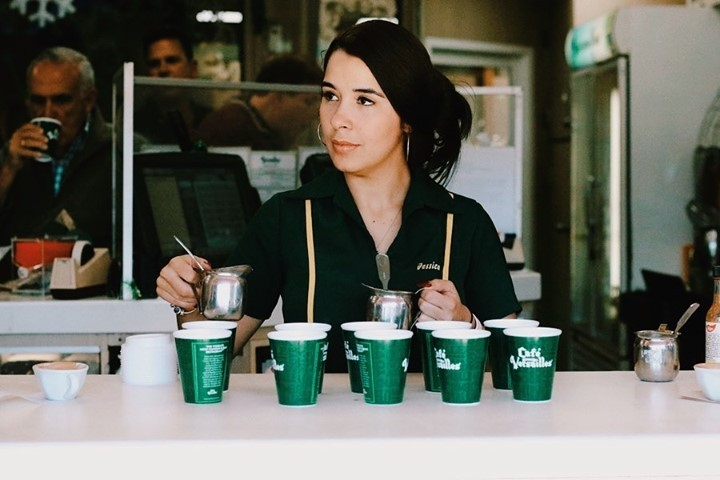Cuban coffee, also known as Café Cubano or Cuban espresso, is a way of life for Cubans. A type of espresso made with finely ground dark-roasted coffee beans, Cuban coffee is sweetened with demerara sugar during brewing. It’s a daily habit for most Cubans, who often enjoy the rich drink with pastries or sandwiches. If you love a strong, sweet, and bold coffee drink, learn how to make Cuban coffee to enjoy for yourself and learn how to differentiate between different types of Cuban coffees.
How to make Cuban coffee

Makers & Finders is a vibrant, upbeat restaurant-café-bar where specialty coffee, inspired Latin food, and hospitality are the program pillars. The full-service experience transforms a coffee shop into a bustling café. Coffee can be handcrafted during dine-in or to-go, depending on the visit. All syrups are handmade by trained baristas, making it the most unique specialty latte menu in Las Vegas.
Equipment
- Moka pot or espresso machine
- Saucepan (for your milk) or milk pitcher for your espresso machine steam wand
- Blender (optional)
Ingredients
- 4 tablespoons of espresso
- 5 ounces of water
- 8 ounces of evaporated milk
- Sugar to taste
Method
- Pour 4 tablespoons of espresso into the middle chamber of the Moka Pot. Firmly press on it with the back of a spoon until it looks even and compact.
- Add 5 ounces of water to the bottom chamber of the Moka Pot. Place on the stovetop at Medium-Low heat. Keep the lid of the Moka Pot open to monitor your espresso. It should take 8-10 minutes to brew.
- Pour the desired amount of sugar or condensed milk into your mug.
- Take 8 ounces of evaporated milk (from the can is just fine). Place it on Medium-Low heat on the stovetop. Bring it to a simmer. Put it in a blender and blend for 20 seconds (to create foam).
- Pour the espresso from the Moka Pot into the mug and whisk vigorously to combine the sugar and espresso. The more you whisk, the better and thicker the mixture will become.
- Pour your foamy, evaporated milk. If you have an espresso machine at home, this is even easier as you can steam your evaporated milk with the steam wand.
History of Cuban coffee

Coffee was not always predominant in Cuba. The plant was first introduced to the island in 1748. By the mid-19th century, coffee had grown to rival sugar as the leading economic product of Cuba. Because of this industry, consumption soared, and coffee became a daily routine for Cubans. By the 1940s, Cuba was the top coffee exporter in the world, producing 60,000 tons from 1960-1961. However, the Cuban Revolution in 1959 devastated this homegrown Cuban industry, removing the country from its status as a global coffee powerhouse. Despite this, coffee remained a huge part of Cuban life on the island and in the large Cuban diaspora in Florida.
Because of this reduction in coffee production, coffee culture changed in Cuba. The Cuban government supplemented this lower supply of coffee by mixing ground coffee with chícharo (a pealike legume) and importing cheaper Robusta beans. The large Cuban immigrant population in Florida has proudly maintained their native coffee tradition. However, although the brewing process in Florida is traditional, the most famous Cuban coffee brands now use Arabica coffee beans sourced from other countries.
Cuban coffee culture

Traditionally, Cuban coffee is brewed in a Moka, a stove-top espresso maker, instead of a coffee pot or a French press. A small amount of coffee is added to a cup containing demerara sugar and mixed until it turns light brown, forming a thick espuma (“foam”). Once the coffee is finished in the Moka, the brew is then poured over the whisked mixture. The puma will rise to the top, producing a darker beverage that’s comparable to strong coffee drinks like Turkish coffee or Italian espresso.
Cuban coffee can be served in small ceramic demitasse cups or plastic cups when purchased from Vanitas, a walk-up coffee vendor. Cubans enjoy coffee throughout the day—breakfast, lunch, or dinner. The beverage also serves an important social function, as opposed to the more solitary and pragmatic usage of coffee in America, where the drink is mainly consumed for caffeine. Many Cubans enjoy coffee as a leisure activity with friends and family, often served to guests in traditional Cuban households.
Variations of Cuban coffee

While Cuban coffee refers to the general coffee drink, there are a few kinds of Cuban coffees to enjoy.
Colada
A colada is a 4-ounce Cuban espresso made with espumita and served in larger amounts (about four- to six-shot servings). Typically, it’s served in small cups meant for sharing. Unlike a Cuban coffee, you’d order only for yourself, it’s one to enjoy among friends and family.
Cortadito
Like the recipe above, a cortadio is a Cuban coffee topped with steamed milk. Made of half milk and half Cuban coffee, it’s served in a medium-sized cup and already has added sugar. Some variations include light or dark (clarity or obscurity), which refers to how much coffee is used in the cortadio.
Cafe Con Leche
The cafe con leche is most similar to the latte, which Cubans often enjoy in the morning. This drink is made with a shot or two of Cuban coffee mixed with hot or steamed milk. The ratio contains far more milk than coffee, making it more of a latte-style drink with less of a pronounced coffee flavor.
Cafecito or café Cubano
This is the strongest of Cuban coffee options, made with a strong shot of Cuban coffee and sugar.




